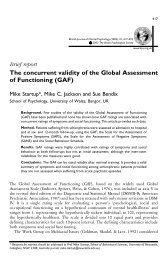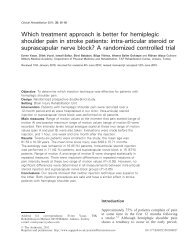Predictive validity of the Hendrich fall risk model II in an acute ...
Predictive validity of the Hendrich fall risk model II in an acute ...
Predictive validity of the Hendrich fall risk model II in an acute ...
You also want an ePaper? Increase the reach of your titles
YUMPU automatically turns print PDFs into web optimized ePapers that Google loves.
Table 4<br />
Psychometric values <strong>of</strong> <strong>Hendrich</strong> <strong>II</strong> Model <strong>in</strong> different studies.<br />
Authors <strong>Hendrich</strong><br />
et al. (2003)<br />
Kim<br />
et al. (2007)<br />
Sensitivity 0.75 0.70 0.86<br />
Specificity 0.74 0.61 0.43<br />
PPV ne 0.02 0.11<br />
NPV<br />
ne, not evaluated.<br />
ne 0.95 0.97<br />
Our higher sensitivity could be related to <strong>the</strong> fact that<br />
<strong>the</strong> <strong>risk</strong> factors <strong>in</strong>cluded <strong>in</strong> <strong>the</strong> <strong>Hendrich</strong> <strong>fall</strong> <strong>risk</strong> <strong>model</strong> are<br />
highly relev<strong>an</strong>t for <strong>the</strong> elderly compar<strong>in</strong>g to a general<br />
hospitalized population admitted to medical–surgical<br />
units or persons younger th<strong>an</strong> 65 years old. In fact giv<strong>in</strong>g<br />
higher scores to confusion <strong>an</strong>d depression (4 <strong>an</strong>d 2<br />
respectively), c<strong>an</strong> help to predict <strong>fall</strong>s <strong>in</strong> geriatric patients<br />
as <strong>the</strong>se conditions are more frequent <strong>in</strong> elderly admitted<br />
to hospital <strong>an</strong>d are recognized as import<strong>an</strong>t <strong>risk</strong> factors for<br />
hospitalized elderly patients (Rubenste<strong>in</strong>, 2006; Scott<br />
et al., 2007).<br />
This study was <strong>the</strong> first one to test this assessment tool<br />
specifically on geriatric patients so far <strong>an</strong>d we could not<br />
know if this discrim<strong>in</strong>ative value depends on characteristics<br />
<strong>of</strong> population admitted to our unit.<br />
Compared to a relatively high specificity <strong>of</strong> <strong>the</strong><br />
<strong>Hendrich</strong> study, <strong>in</strong> our study <strong>the</strong> specificity was quite<br />
low, with proportion <strong>of</strong> false-positive <strong>fall</strong>ers (<strong>risk</strong>-score<br />
patients who did not <strong>fall</strong>) <strong>of</strong> 57%. This was not completely<br />
unexpected s<strong>in</strong>ce lower specificity values have been found<br />
frequently by researchers o<strong>the</strong>r th<strong>an</strong> those who developed<br />
<strong>the</strong> <strong>risk</strong> assessment tools because <strong>of</strong> sett<strong>in</strong>gs <strong>an</strong>d population<br />
ch<strong>an</strong>ges (Oliver et al., 2004).<br />
Accord<strong>in</strong>g to Myers, on <strong>the</strong> accuracy calculations two<br />
confounders c<strong>an</strong> have impact: treatment paradox <strong>an</strong>d<br />
ward prevention measures. Treatment paradox occurs<br />
when nurses are aware <strong>of</strong> <strong>the</strong> <strong>risk</strong> scores <strong>an</strong>d implement<br />
<strong>fall</strong> prevention measures for high <strong>risk</strong> patients <strong>an</strong>d not for<br />
low <strong>risk</strong> patients. For this reason it is import<strong>an</strong>t that nurses<br />
rema<strong>in</strong> bl<strong>in</strong>d to <strong>the</strong> results <strong>of</strong> <strong>the</strong> assessment when test<strong>in</strong>g<br />
<strong>the</strong> accuracy <strong>of</strong> a tool. Even if nurses are bl<strong>in</strong>d to <strong>the</strong> <strong>risk</strong><br />
assessment it is likely that some type <strong>of</strong> <strong>fall</strong> prevention<br />
protocol is <strong>in</strong> place <strong>in</strong> <strong>the</strong> hospital sett<strong>in</strong>g. Fall might<br />
<strong>the</strong>refore be prevented by normal ward practices. This<br />
issue is difficult to counter as it would be unethical to ask<br />
nurs<strong>in</strong>g staff not to implement <strong>fall</strong> prevention measures<br />
(Myers, 2003).<br />
This could be occurred also <strong>in</strong> our study as, even if <strong>in</strong> <strong>the</strong><br />
geriatric unit do not exist a formal protocol for prevent<strong>in</strong>g<br />
<strong>fall</strong>s, <strong>the</strong> nurses pl<strong>an</strong> <strong>an</strong>d implement <strong>fall</strong> preventive<br />
<strong>in</strong>terventions when <strong>the</strong>y judge that a patient is at high<br />
<strong>risk</strong> on <strong>the</strong> basis <strong>of</strong> <strong>the</strong>ir cl<strong>in</strong>ical nurs<strong>in</strong>g assessment at <strong>the</strong><br />
patient admission. For example, if <strong>the</strong> older patient is<br />
confused or agitated <strong>the</strong>y usually ask one <strong>of</strong> <strong>the</strong> relatives to<br />
stay by <strong>the</strong> older patients dur<strong>in</strong>g <strong>the</strong> day <strong>an</strong>d/or <strong>the</strong> night;<br />
<strong>the</strong> nurses check more <strong>an</strong>d more times patients considered<br />
at <strong>risk</strong> <strong>of</strong> <strong>fall</strong><strong>in</strong>g dur<strong>in</strong>g <strong>the</strong>ir shifts; moreover <strong>the</strong> relatives<br />
employ family assist<strong>an</strong>ts to help <strong>the</strong>ir elderly dur<strong>in</strong>g <strong>the</strong><br />
hospital stay whe<strong>the</strong>r <strong>the</strong>y have some physical limitations.<br />
These <strong>in</strong>terventions c<strong>an</strong> be effective <strong>an</strong>d reduce <strong>the</strong> <strong>risk</strong> <strong>of</strong><br />
<strong>fall</strong><strong>in</strong>g <strong>in</strong> some patients at <strong>risk</strong>.<br />
D. Ivziku et al. / International Journal <strong>of</strong> Nurs<strong>in</strong>g Studies 48 (2011) 468–474 473<br />
Ivziku et al.<br />
(current study)<br />
One more expl<strong>an</strong>ation could be that severely impaired<br />
patient <strong>an</strong>d patient’s family may become more aware <strong>of</strong><br />
<strong>the</strong> <strong>risk</strong> <strong>of</strong> <strong>fall</strong><strong>in</strong>g <strong>in</strong> hospital sett<strong>in</strong>gs <strong>an</strong>d consequently<br />
better protected those at <strong>risk</strong> apply<strong>in</strong>g some precautions.<br />
In addition, <strong>the</strong> patient health conditions c<strong>an</strong> improve<br />
dur<strong>in</strong>g <strong>the</strong> hospital stay <strong>an</strong>d consequently <strong>the</strong> <strong>risk</strong> scores<br />
c<strong>an</strong> ch<strong>an</strong>ge, so <strong>the</strong> admission score, that we used <strong>in</strong> our<br />
research to assess <strong>the</strong> <strong>risk</strong>, might not represent <strong>the</strong> <strong>risk</strong> <strong>of</strong><br />
<strong>the</strong> patients dur<strong>in</strong>g his/her hospital stay.<br />
The weak specificity <strong>of</strong> a <strong>fall</strong> <strong>risk</strong> assessment tool is <strong>of</strong><br />
some relev<strong>an</strong>t concern when evaluat<strong>in</strong>g its cl<strong>in</strong>ical utility,<br />
because m<strong>an</strong>y patients who do not <strong>fall</strong> are identified at<br />
high <strong>risk</strong>. This has implications for <strong>the</strong> implementation <strong>of</strong><br />
<strong>fall</strong> prevention <strong>in</strong>terventions that should be ma<strong>in</strong>ly<br />
targeted at those at high <strong>risk</strong>. Fall prevention programs<br />
may lose some <strong>of</strong> <strong>the</strong>ir signific<strong>an</strong>ce if staff perceives that<br />
too m<strong>an</strong>y patients are identified at high <strong>risk</strong> for <strong>fall</strong>s.<br />
We found <strong>an</strong> <strong>in</strong>ter-rater reliability very similar to that<br />
calculated <strong>in</strong> <strong>the</strong> Kim et al.‘s study (k = 0.81 vs 0.87). The<br />
<strong>an</strong>alysis <strong>of</strong> <strong>the</strong> reasons <strong>of</strong> rater disagreement <strong>in</strong>dicated <strong>the</strong><br />
need to <strong>in</strong>clude <strong>in</strong> <strong>the</strong> tra<strong>in</strong><strong>in</strong>g program more examples <strong>an</strong>d<br />
expl<strong>an</strong>ations about particular cl<strong>in</strong>ical situations (for example<br />
how to score <strong>the</strong> patient with prescription <strong>of</strong> benzodiazep<strong>in</strong>e<br />
at occurrence, patients with cognitive<br />
impairment, temporary or perm<strong>an</strong>ent vertigo at admission).<br />
5. Study limitations<br />
Even though <strong>the</strong> <strong>in</strong>ter-rater reliability <strong>in</strong> our study was<br />
quite high, <strong>the</strong> r<strong>an</strong>ge <strong>of</strong> CI at 95% <strong>of</strong> 0.71–1.00 <strong>in</strong>dicated<br />
that it should have been necessary to test a higher sample<br />
size <strong>in</strong> order to have a power at least <strong>of</strong> 0.80 with <strong>an</strong> alpha<br />
<strong>of</strong> 0.05 as <strong>the</strong> literature suggests (Papaio<strong>an</strong>nou et al., 2004).<br />
Moreover this study presents a low number <strong>of</strong> patients<br />
studied due to <strong>the</strong> small number <strong>of</strong> beds <strong>in</strong> our geriatric<br />
unit <strong>an</strong>d to <strong>the</strong> short period <strong>of</strong> study. Even if <strong>the</strong> total <strong>fall</strong><br />
rate <strong>of</strong> 7.5 per 1000 patient days is consistent with <strong>the</strong><br />
r<strong>an</strong>ge <strong>of</strong> <strong>the</strong> rates reported <strong>in</strong> <strong>the</strong> literature, <strong>the</strong> number <strong>of</strong><br />
<strong>fall</strong>s recorded (n = 14) is very limited <strong>an</strong>d do not permit to<br />
generalize our results. In addition, as <strong>the</strong> research was<br />
carried out <strong>in</strong> one s<strong>in</strong>gle geriatric unit, fur<strong>the</strong>r validation<br />
studies will be necessary to extend <strong>the</strong> use <strong>in</strong> o<strong>the</strong>r<br />
geriatric units or on <strong>the</strong> general elderly population<br />
admitted to hospital.<br />
We did not reassess <strong>the</strong> patients when <strong>the</strong> cl<strong>in</strong>ical<br />
conditions ch<strong>an</strong>ged to not burden <strong>the</strong> nurses work<strong>in</strong>g <strong>in</strong><br />
<strong>the</strong> unit. We do not know if <strong>the</strong> <strong>fall</strong> <strong>risk</strong> score rema<strong>in</strong>ed <strong>the</strong><br />
same or ch<strong>an</strong>ged just prior to <strong>the</strong> <strong>fall</strong>. Elderly patients<br />
should be reassessed dur<strong>in</strong>g <strong>the</strong>ir hospital stay as <strong>the</strong>ir<br />
health conditions c<strong>an</strong> ch<strong>an</strong>ge rapidly, <strong>an</strong>d new medications<br />
c<strong>an</strong> be prescribed (<strong>Hendrich</strong> et al., 2003).<br />
We did not compare <strong>the</strong> HFRM with o<strong>the</strong>r <strong>fall</strong> <strong>risk</strong><br />
assessment tools to evaluate <strong>the</strong> different discrim<strong>in</strong>ative<br />
power <strong>an</strong>d <strong>the</strong> effectiveness <strong>of</strong> different tools. A comparison<br />
with o<strong>the</strong>r tools could be useful to verify <strong>the</strong> power <strong>of</strong><br />
o<strong>the</strong>r <strong>risk</strong> factors <strong>an</strong>d tools <strong>in</strong> our population.<br />
6. Conclusions<br />
The use <strong>of</strong> quick, reliable <strong>an</strong>d valid <strong>fall</strong> <strong>risk</strong> tools to<br />
identify high <strong>risk</strong> patients <strong>an</strong>d to elicit fur<strong>the</strong>r <strong>fall</strong> related
















